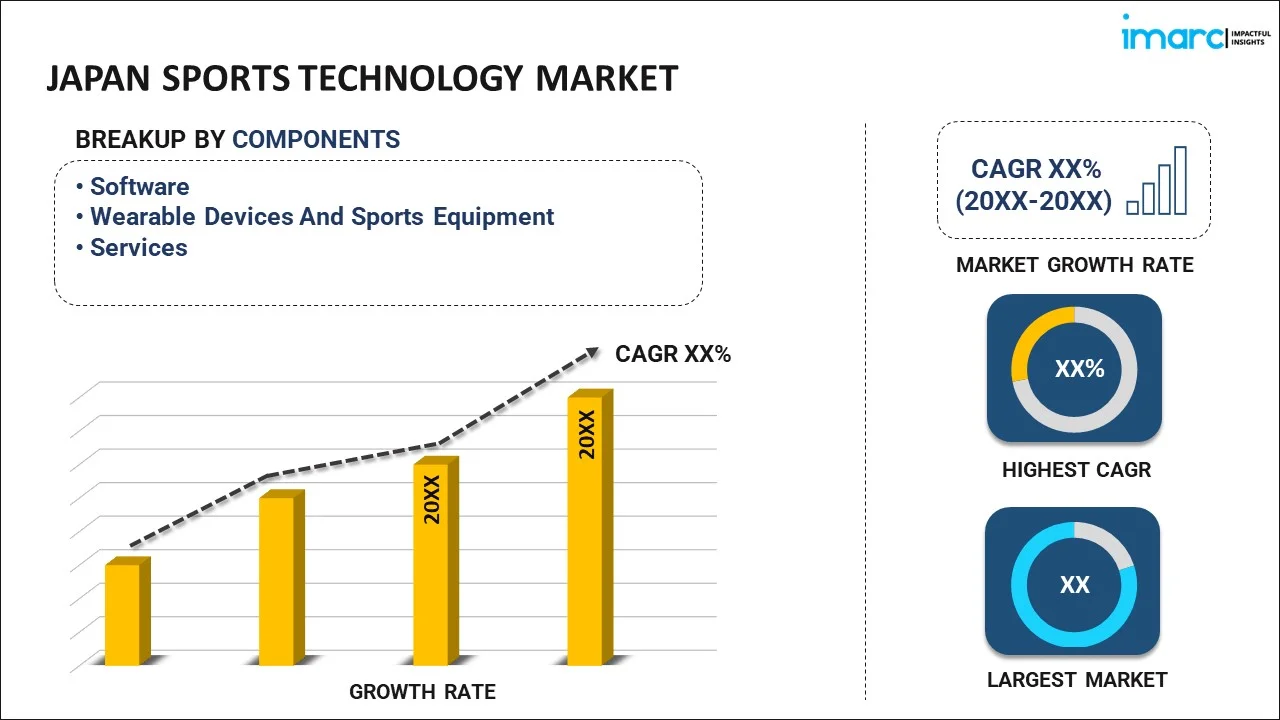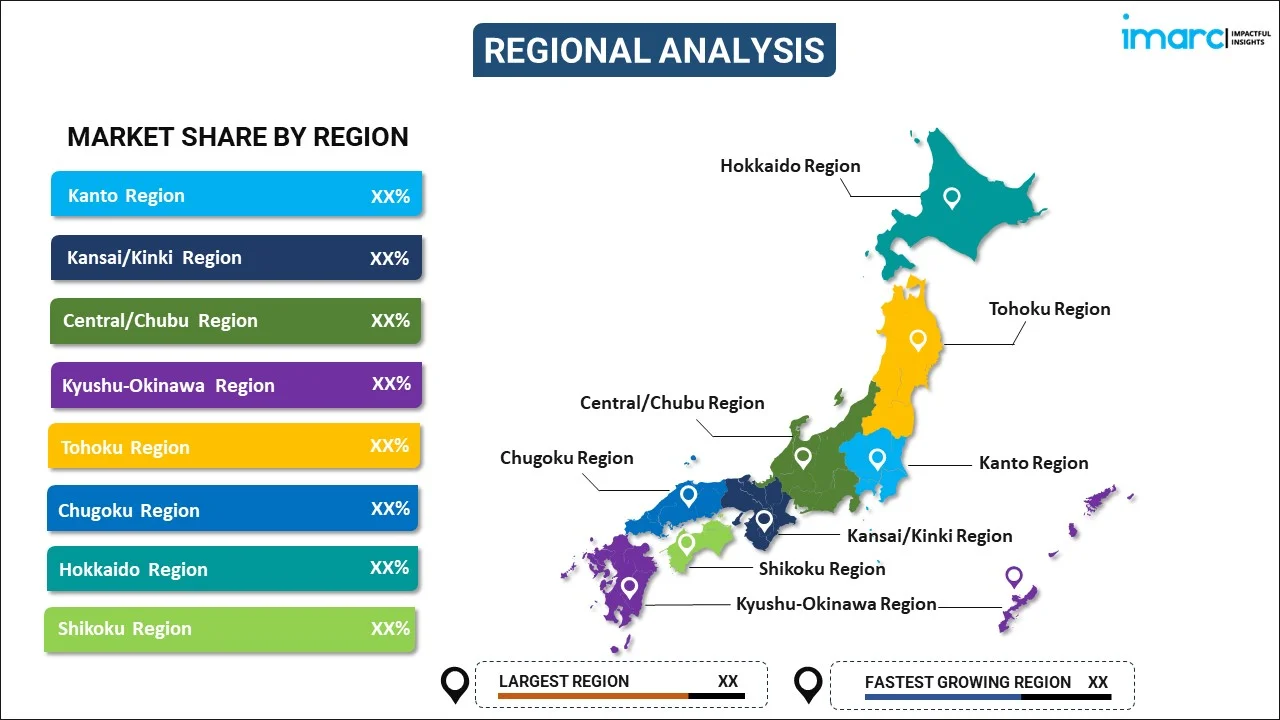
Japan Sports Technology Market Report by Component (Software, Wearable Devices And Sports Equipment, Services), Technology (Artificial Intelligence/Machine Learning (AI/ML), Internet of Things (Iot), Augmented Reality/Virtuality (AR/VR)), Sport (Soccer, Baseball, Basketball, Ice hockey, American Football/Rugby, Tennis, Cricket, Golf, Esports, and Others), Application (Tracking, Decision Making and Team Analysis and Management, Analytics And Statistics, Tactics and Simulation, Training, Game Performance Analysis and Injury and Health Analysis), End User (Coaches, Clubs, Leagues, Sports associations, and Others), and Region 2025-2033
Market Overview:
The Japan sports technology market size reached USD 1.0 Billion in 2024. Looking forward, IMARC Group expects the market to reach USD 1.8 Billion by 2033, exhibiting a growth rate (CAGR) of 6.84% during 2025-2033. The rising sports enthusiast culture, significant technological advancements, recent hosting of Olympic and paralympic sports, rising health and fitness awareness, increasing investment in sports technology startups, and rapidly aging population represent some of the key factors driving the market.
|
Report Attribute
|
Key Statistics
|
|---|---|
|
Base Year
|
2024
|
|
Forecast Years
|
2025-2033
|
|
Historical Years
|
2019-2024
|
| Market Size in 2024 | USD 1.0 Billion |
| Market Forecast in 2033 | USD 1.8 Billion |
| Market Growth Rate 2025-2033 | 6.84% |
Sports technology refers to the innovative tools, equipment, and methodologies employed in the world of sports to enhance performance, safety, and the overall spectator experience. It encompasses a wide range of advancements, from wearable fitness trackers and smart sports equipment to data analytics and video analysis software. These technologies have revolutionized the way athletes train, compete, and recover. One prominent aspect of sports technology is wearable devices like fitness trackers and smartwatches. Athletes and coaches use these gadgets to monitor crucial metrics, such as heart rate, distance covered, and calories burned, allowing for precise training and performance optimization. Additionally, advanced materials and design techniques have led to the development of high-performance sports gear such as lightweight, aerodynamic clothing and state-of-the-art footwear.
Japan Sports Technology Market Trends:
Japan has a rich and deeply ingrained sports culture, with a strong passion for various sports, including baseball, soccer, and sumo wrestling. This culture fosters a demand for advanced technologies that can enhance athletic performance, training methods, and the overall sporting experience. Additionally, the recent hosting of the 2020 Summer Olympics and Paralympics in Tokyo provided a platform to showcase sports technology solutions. The events served as a catalyst for investment in sports tech infrastructure, with a focus on improving athlete performance and fan engagement. Other than this, the growing awareness about the importance of health and fitness has led to an increased interest in sports technology among individuals and fitness enthusiasts. Wearable fitness trackers, smartwatches, and health monitoring apps are gaining popularity as tools for tracking physical activity and health metrics. Besides this, Japan has seen a surge in investment in sports technology startups and companies specializing in sports-related innovations. Venture capital firms and corporate sponsors are recognizing the potential of this market and are providing funding to accelerate the development and adoption of sports tech solutions. In line with this, the aging population of Japan has created a demand for technologies that support active and healthy aging. Sports technology can play a vital role in providing seniors with tools to maintain physical fitness and monitor their health, thereby contributing to their overall well-being. Moreover, sports technology is about improving athlete performance and also enhancing the fan experience. The sports leagues and teams of Japan are embracing digital solutions, such as virtual reality (VR), augmented reality (AR), and interactive mobile apps, to engage fans and create immersive experiences. Moreover, Japan is renowned for its technological prowess and innovation. The commitment of the nation to research and development has resulted in the creation of cutting-edge sports technologies, including wearable devices, performance analytics, and biomechanics solutions. These innovations are driving the adoption of sports technology among athletes and teams.
Japan Sports Technology Market Segmentation:
IMARC Group provides an analysis of the key trends in each segment of the market, along with forecasts at the country level for 2025-2033. Our report has categorized the market based on component, technology, sports, application, and end user.
Component Insights:

- Software
- Wearable Devices and Sports Equipment
- Services
The report has provided a detailed breakup and analysis of the market based on the component. This includes software, wearable devices and sports equipment, and services.
Technology Insights:
- Artificial Intelligence/Machine Learning (AI/ML)
- Internet of Things (IoT)
- Augmented Reality/Virtuality (AR/VR)
A detailed breakup and analysis of the market based on the technology have also been provided in the report. This includes artificial intelligence/machine learning (AI/ML), internet of things (IoT), and augmented reality/virtuality (AR/VR).
Sports Insights:
- Soccer
- Baseball
- Basketball
- Ice hockey
- American Football/Rugby
- Tennis
- Cricket
- Golf
- Esports
- Others
The report has provided a detailed breakup and analysis of the market based on the sports. This includes soccer, baseball, basketball, ice hockey, american football/rugby, tennis, cricket, golf, esports, and others.
Application Insights:
- Tracking
- Decision Making and Team Analysis and Management
- Analytics and Statistics
- Tactics and Simulation
- Training
- Game Performance Analysis and Injury and Health Analysis
A detailed breakup and analysis of the market based on the application have also been provided in the report. This includes tracking, decision making and team analysis and management, analytics and statistics, tactics and simulation, training, and game performance analysis and injury and health analysis.
End User Insights:
- Coaches
- Clubs
- Leagues
- Sports associations
- Others
The report has provided a detailed breakup and analysis of the market based on the end user. This includes coaches, clubs, leagues, sports associations, and others.
Regional Insights:

- Kanto Region
- Kansai/Kinki Region
- Central/ Chubu Region
- Kyushu-Okinawa Region
- Tohoku Region
- Chugoku Region
- Hokkaido Region
- Shikoku Region
The report has also provided a comprehensive analysis of all the major regional markets, which include Kanto Region, Kansai/Kinki Region, Central/ Chubu Region, Kyushu-Okinawa Region, Tohoku Region, Chugoku Region, Hokkaido Region, and Shikoku Region.
Competitive Landscape:
The market research report has also provided a comprehensive analysis of the competitive landscape. Competitive analysis such as market structure, key player positioning, top winning strategies, competitive dashboard, and company evaluation quadrant has been covered in the report. Also, detailed profiles of all major companies have been provided.
Japan Sports Technology Market Report Coverage:
| Report Features | Details |
|---|---|
| Base Year of the Analysis | 2024 |
| Historical Period | 2019-2024 |
| Forecast Period | 2025-2033 |
| Units | Billion USD |
| Scope of the Report | Exploration of Historical Trends and Market Outlook, Industry Catalysts and Challenges, Segment-Wise Historical and Future Market Assessment:
|
| Components Covered | Software, Wearable Devices And Sports Equipment, Services |
| Technologies Covered | Artificial Intelligence/Machine Learning (AI/ML), Internet of Things (Iot), Augmented Reality/Virtuality (AR/VR) |
| Sports Covered | Soccer, Baseball, Basketball, Ice hockey, American Football/Rugby, Tennis, Cricket, Golf, Esports, Others |
| Applications Covered | Tracking, Decision Making and Team Analysis and Management, Analytics And Statistics, Tactics and Simulation, Training, Game Performance Analysis and Injury and Health Analysis |
| End Users Covered | Coaches, Clubs, Leagues, Sports associations, Others |
| Regions Covered | Kanto Region, Kansai/Kinki Region, Central/ Chubu Region, Kyushu-Okinawa Region, Tohoku Region, Chugoku Region, Hokkaido Region, Shikoku Region |
| Customization Scope | 10% Free Customization |
| Post-Sale Analyst Support | 10-12 Weeks |
| Delivery Format | PDF and Excel through Email (We can also provide the editable version of the report in PPT/Word format on special request) |
Key Questions Answered in This Report:
- How has the Japan sports technology market performed so far and how will it perform in the coming years?
- What has been the impact of COVID-19 on the Japan sports technology market?
- What is the breakup of the Japan sports technology market on the basis of component?
- What is the breakup of the Japan sports technology market on the basis of technology?
- What is the breakup of the Japan sports technology market on the basis of sports?
- What is the breakup of the Japan sports technology market on the basis of application?
- What is the breakup of the Japan sports technology market on the basis of end user?
- What are the various stages in the value chain of the Japan sports technology market?
- What are the key driving factors and challenges in the Japan sports technology?
- What is the structure of the Japan sports technology market and who are the key players?
- What is the degree of competition in the Japan sports technology market?
Key Benefits for Stakeholders:
- IMARC’s industry report offers a comprehensive quantitative analysis of various market segments, historical and current market trends, market forecasts, and dynamics of the Japan sports technology market from 2019-2033.
- The research report provides the latest information on the market drivers, challenges, and opportunities in the Japan sports technology market.
- Porter's five forces analysis assist stakeholders in assessing the impact of new entrants, competitive rivalry, supplier power, buyer power, and the threat of substitution. It helps stakeholders to analyze the level of competition within the Japan sports technology industry and its attractiveness.
- Competitive landscape allows stakeholders to understand their competitive environment and provides an insight into the current positions of key players in the market.
Need more help?
- Speak to our experienced analysts for insights on the current market scenarios.
- Include additional segments and countries to customize the report as per your requirement.
- Gain an unparalleled competitive advantage in your domain by understanding how to utilize the report and positively impacting your operations and revenue.
- For further assistance, please connect with our analysts.
 Request Customization
Request Customization
 Speak to an Analyst
Speak to an Analyst
 Request Brochure
Request Brochure
 Inquire Before Buying
Inquire Before Buying




.webp)




.webp)












